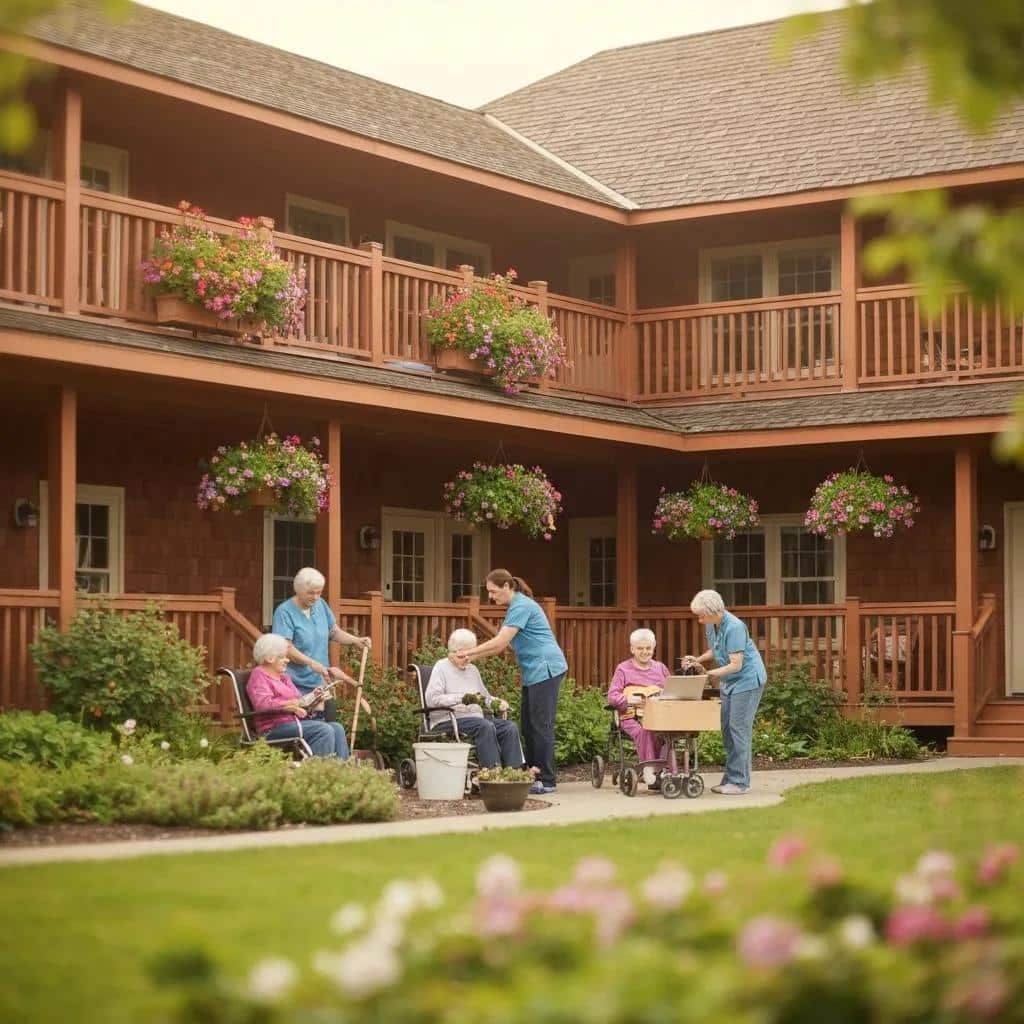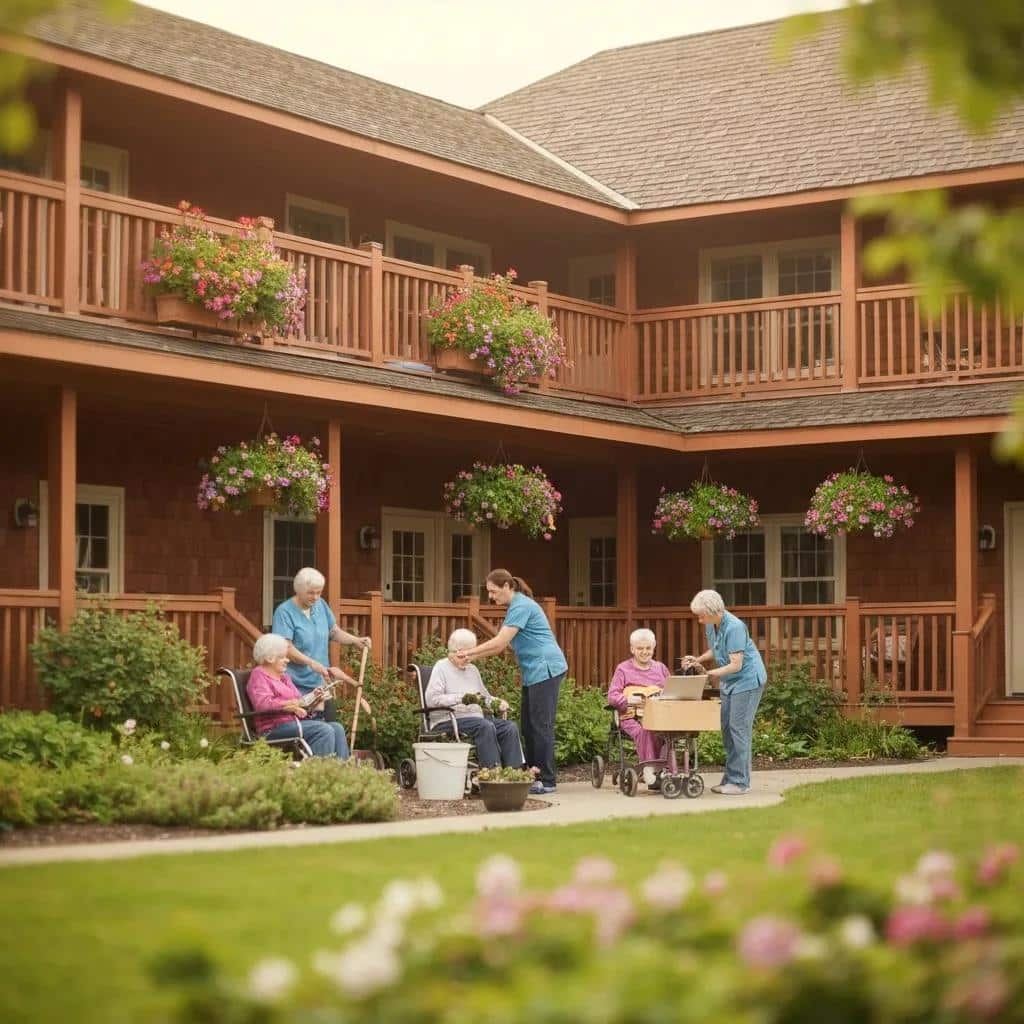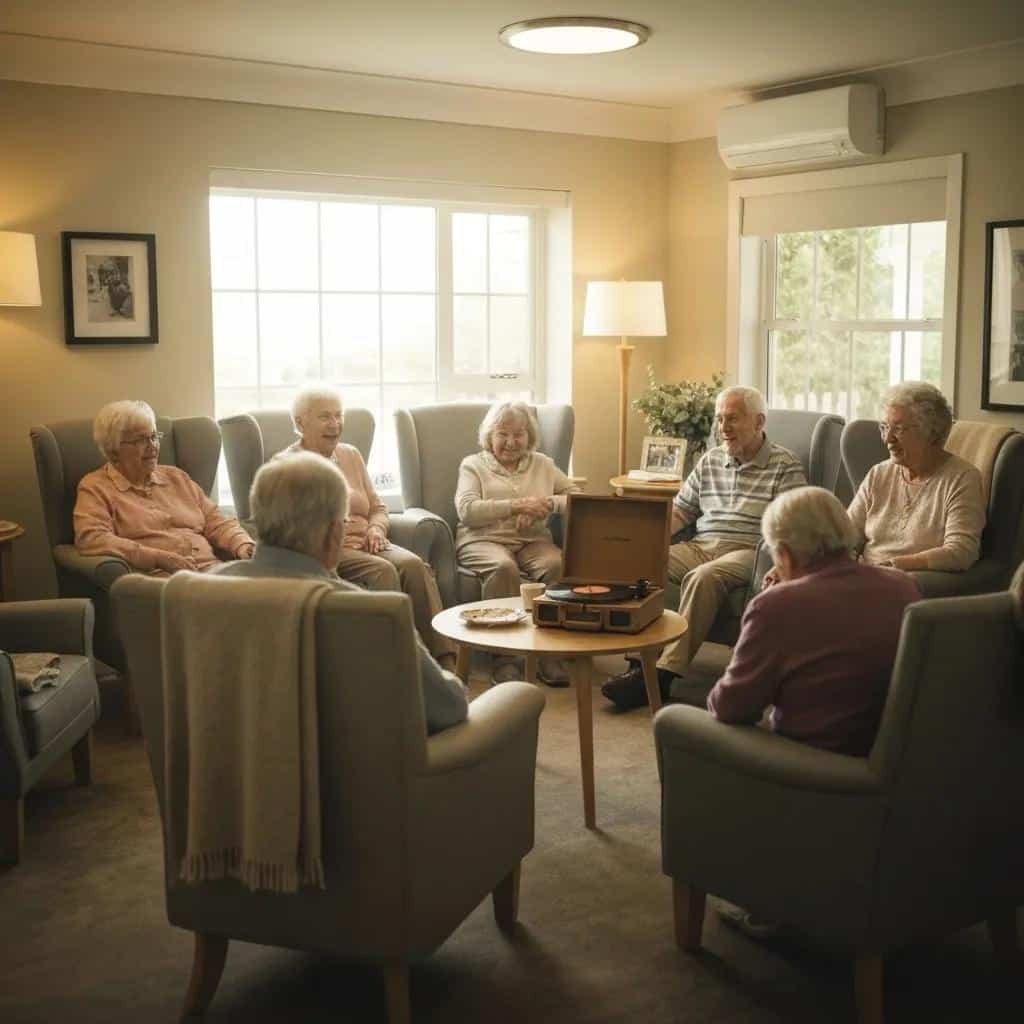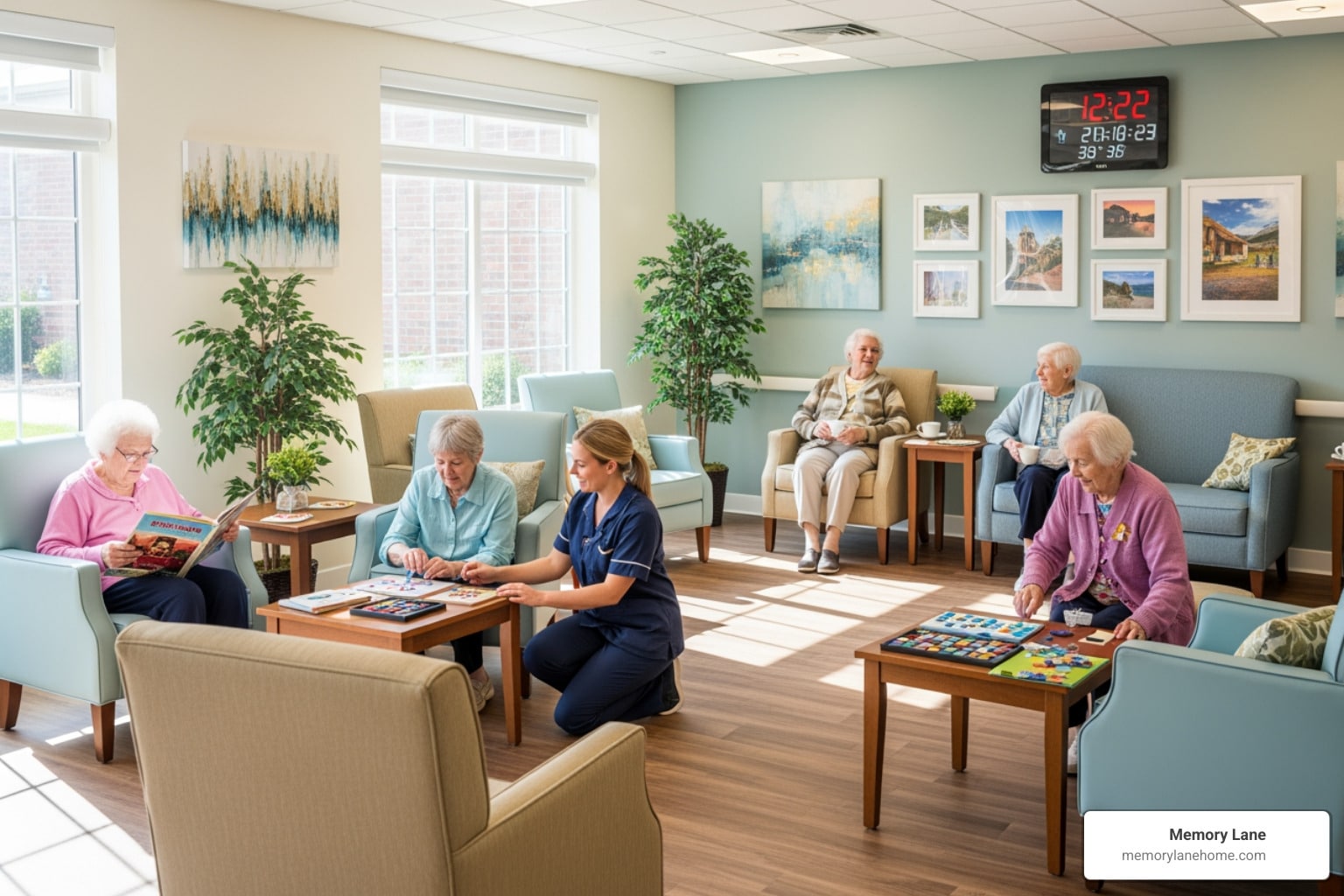Explore advanced memory care. Understand specialized dementia support, recognize signs, and find the right facility for your loved one.

Expert Tips for Selecting Memory Care Facilities Near Me
Expert Tips for Selecting Memory Care Facilities Near Me

How to Choose the Right Alzheimer’s Memory Care Facility Near Me
Finding a memory care facility that truly understands Alzheimer’s and dementia challenges can transform daily experiences for seniors and relieve families of constant worry. As memory loss progresses, familiar routines become strained and safety concerns rise, making specialized support essential. This guide offers a clear path to locating memory care facilities near you, defining key concepts, comparing living options, exploring costs and daily life, and highlighting how community resources and expert staff converge to deliver personalized, home-like care.
In this article, you will discover:
- What memory care entails and how it differs from other senior living options
- Criteria for choosing the best local memory care facility
- Transparent cost insights and financial aid strategies
- A snapshot of daily life, therapeutic activities, and amenities in Ypsilanti and Ann Arbor memory care
- Practical resources for families, legal planning essentials, and caregiver support networks
- Profiles of qualified staff and leadership roles that foster better resident outcomes
- Emerging trends—technology, person-centered models, and program innovations—that shape future dementia care
What Is Memory Care and How Does It Support Alzheimer’s and Dementia Patients?
Memory care is a specialized form of assisted living designed to support individuals with Alzheimer’s disease and other dementias through structured routines, therapeutic environments, and enhanced safety measures. By focusing on memory stimulation, secure neighborhoods, and personalized support, memory care programs improve cognitive function, reduce agitation, and foster resident engagement.
Memory care facilities integrate daily cognitive exercises, validated through therapeutic research, to reinforce neural pathways. As a result, residents experience greater independence, consistent routines that lower anxiety, and interventions that slow functional decline. This targeted approach directly supports quality of life for seniors facing progressive memory loss.
What Are the Key Differences Between Memory Care and Other Senior Living Options?
How Does Memory Care Improve Quality of Life for Seniors with Alzheimer’s?
Memory care enhances daily life through three primary benefits:
- Consistent Routine Support – Regular schedules reduce confusion and agitation
- Cognitive Engagement – Tailored activities stimulate memory recall and social interaction
- Emotional Safety – Secure environments and compassionate staff promote comfort
The Impact of Structured Routines on Dementia Patients – in English
Research indicates that consistent routines significantly reduce agitation and confusion in individuals with dementia, leading to improved cognitive function and a greater sense of independence. Structured environments and predictable daily schedules are key components of effective memory care.
Alzheimer’s Association, “Memory Care: What You Need to Know” (2024)
What Specialized Services Are Included in Memory Care Facilities?

- Therapeutic Activities Program: Facilitates art, music, and cognitive stimulation
- Personalized Care Plans: Adapts assistance levels to individual abilities and preferences
- Secure Outdoor Spaces: Enables safe wandering and nature engagement
- 24/7 Cognitive Monitoring: Ensures prompt response to behavioral changes
- Memory Cue Environments: Uses signage and familiar objects to reinforce orientation
How to Identify the Best Memory Care Facilities Near Me for Alzheimer’s Care
When searching for the best memory care facilities for Alzheimer’s care, it’s crucial to approach the task with a clear understanding of what these specialized environments offer. Memory care facilities are designed specifically to cater to the unique needs of individuals living with Alzheimer’s and other forms of dementia. To identify the best options nearby, one should start by researching the credentials and experience of each facility. Look for places that have licensed staff trained in dementia care, as well as programs that focus on cognitive stimulation and personal engagement. Additionally, consider the facility’s reputation by checking reviews and seeking recommendations from healthcare professionals or support groups.
Another essential factor to assess is the facility’s approach to care and activities. The best memory care facilities will offer structured daily routines that promote independence while ensuring safety. Families should also inquire about the staff-to-resident ratio, as higher ratios often indicate more personalized attention. Visiting potential facilities can provide valuable insight into the living environment and community atmosphere. During the visit, pay attention to the interactions between staff and residents, and ask about the variety of programs and activities that encourage socialization and mental engagement. Overall, a comprehensive evaluation that includes both research and personal visits is essential for identifying the ideal memory care facility for loved ones with Alzheimer’s.
What Are the Essential Features to Look for in a Memory Care Facility?
A top-rated memory care community exhibits these hallmarks:
- a home-like environment with comfortable, private rooms
- a high caregiver-to-resident ratio guaranteeing individualized attention
- Dementia-specific staff training, including handling of common behavioral symptoms
- Secure layouts with controlled access and clear wayfinding
- Engagement calendars offering daily therapeutic and social activities
How Can Personalized Care Plans Benefit Residents with Dementia?
Personalized care plans optimize well-being by aligning services with each resident’s:
- Cognitive strengths and challenges
- Daily preferences and life history
- Physical health requirements
- Emotional and social needs
The Role of Personalized Care Plans in Dementia Care – in English
Studies show that personalized care plans, tailored to individual needs and preferences, enhance the quality of life for people with dementia. These plans consider cognitive strengths, life history, and emotional needs to reduce frustration and promote a sense of familiarity.
National Institute on Aging, “Dementia: What It Is, Symptoms, Types, and Diagnosis” (2023)
What Questions Should Families Ask When Touring Memory Care Facilities?
When you visit potential memory care communities, consider asking:
- What is your caregiver-to-resident ratio during peak hours?
- How are care plans developed and updated to reflect resident needs?
- What safety protocols exist for wandering or emergency response?
- How do you measure the effectiveness of therapeutic activities?
- Can you describe a typical day for a resident with moderate dementia?
What Is the Cost of Memory Care and What Financial Assistance Options Are Available?
When considering the cost of memory care, families often find themselves navigating a complex landscape of expenses that can vary significantly based on factors such as location, facility type, and level of care required. On average, memory care services in the United States can range from $3,000 to $7,000 per month, with luxury facilities potentially charging much more. This comprehensive care includes specialized programs tailored to individuals with Alzheimer’s disease or other types of dementia, encompassing assistance with daily activities, structured cognitive therapies, and enhanced security to ensure resident safety. Understanding these costs is crucial for families planning for their loved ones’ long-term care needs, as well as for budgeting potential expenses that can accumulate over time.
Fortunately, various financial assistance options are available to help alleviate the burden of memory care costs. Families may explore Medicaid, a state and federal program that offers benefits for long-term care, including memory care services, depending on eligibility. Veterans may also qualify for the Aid and Attendance benefit, which provides additional financial support for those who have served in the military. Other resources include long-term care insurance, which can cover some of the expenses, and specific local or nonprofit organizations that might offer financial aid or sliding scale fees. By researching and utilizing these options, families can find a sustainable approach to managing the costs of memory care while ensuring their loved ones receive the necessary support and specialized care.
Does Medicare, Medicaid, or VA Benefits Cover Memory Care Expenses?
When considering the financial aspects of long-term care, many families often wonder whether essential programs like Medicare, Medicaid, or Veterans Affairs (VA) benefits can help cover memory care expenses. Memory care facilities are specifically designed to cater to individuals suffering from Alzheimer’s disease, dementia, and other cognitive impairments, offering specialized services that are crucial for their wellbeing. However, understanding how these funding sources apply to memory care can be quite complex and varies significantly based on individual circumstances.
- Medicaid Waivers: Cover in-home services and some facility costs for eligible seniors
- Medicare: Does not generally cover long-term custodial care, but may pay for short rehabilitative stays
- VA Aid & Attendance: Offers monthly stipends to qualified veterans or surviving spouses for long-term care
What Are the Best Strategies for Planning and Managing Memory Care Costs?
When it comes to planning and managing memory care costs, several effective strategies can help families navigate the often overwhelming financial landscape. Firstly, thorough research is crucial. Families should begin by understanding the various types of memory care facilities available, which range from assisted living to specialized memory care homes. Each type comes with different costs and services, so a comparative analysis can indicate which option aligns best with both the individual’s needs and the family’s budget. Additionally, it is essential to consider the specifics of location, as costs can vary significantly based on geographic factors. By gathering information about local facilities, families can establish a realistic financial goal. Effective financial planning combines multiple approaches:
- Utilizing long-term care insurance benefits
- Applying for Medicaid waivers and veterans’ benefits early
- Structuring retirement assets to qualify for aid without depleting resources
- Exploring community-sponsored respite programs for temporary assistance
Proactive discussions with financial advisors and elder law attorneys ensure that families maximize available support while preserving security.
What Does Daily Life Look Like at a Memory Care Facility in Ypsilanti and Ann Arbor?
Daily life at a memory care facility in Ypsilanti and Ann Arbor is thoughtfully structured to cater to the unique needs of residents experiencing memory-related challenges, such as Alzheimer’s disease or other forms of dementia. Each day typically begins with a gentle morning routine that focuses on comfort and familiarity. Residents might start with a warm breakfast in a communal dining area, where they can enjoy nutritious meals while engaging in conversation with peers and staff. This social aspect is crucial, as it fosters a sense of belonging and community, essential for emotional well-being.
As the day progresses, a variety of engaging activities are offered to stimulate cognitive function and encourage social interaction. These activities can include arts and crafts, music therapy, gardening, and reminiscence sessions, which allow participants to share memories and connect with familiar stories. Staff members, often trained in memory care techniques, provide personalized support and guidance, ensuring that each resident can participate at their comfort level. Afternoon programs may also incorporate gentle exercise and outdoor strolls, promoting physical health and encouraging residents to enjoy the natural beauty of their surroundings. Overall, daily life in these facilities is not only a routine but a nurturing environment designed to enhance the quality of life for individuals dealing with memory impairments.

Residents at specialized memory care homes in the Ypsilanti and Ann Arbor area engage in thoughtfully designed days that foster familiarity, stimulation, and community.
What Therapeutic Activities and Programs Support Alzheimer’s Residents?
When it comes to enhancing the quality of life for residents living with Alzheimer’s disease, therapeutic activities and programs play a crucial role. These interventions are designed not only to stimulate cognitive function but also to foster emotional well-being and social interaction. Activities such as art therapy, music therapy, and reminiscence therapy have proven particularly effective. Art therapy allows individuals to express themselves creatively, which can be therapeutic in itself while helping to evoke memories and emotions. Similarly, music therapy taps into the powerful connection between music and memory, often bringing residents joy and moments of clarity, regardless of how advanced the disease may be. A balanced activities schedule reinforces cognitive and emotional wellness:
Benefits of Therapeutic Activities in Memory Care – in English
Research highlights the positive impact of therapeutic activities, such as music therapy and art expression, on individuals with Alzheimer’s disease and other dementias. These activities stimulate memory recall, enhance mood, and promote social interaction.
American Occupational Therapy Association, “Occupational Therapy and Dementia” (2022)
How Does a High Caregiver-to-Resident Ratio Enhance Safety and Well-Being?
A high caregiver-to-resident ratio plays a pivotal role in enhancing the safety and well-being of individuals in assisted living facilities and nursing homes. When there are more caregivers available relative to the number of residents, it allows for personalized attention and timely responses to individual needs. This significantly reduces the likelihood of accidents and medical emergencies, as caregivers can closely monitor the health and behavior of residents. With adequate staffing, caregivers can also dedicate more time to building meaningful relationships with residents, which fosters an atmosphere of trust and comfort. This relationship not only promotes emotional well-being but also encourages residents to communicate their needs and concerns more openly. Maintaining a ratio of one staff member for every three to four residents ensures:
- Prompt response to medical or behavioral changes
- Frequent engagement to prevent loneliness and wandering
- Close observation for emerging health concerns
This staffing model fosters trust, reduces risk, and creates consistent relationships that encourage resident cooperation and reassurance.
What Amenities and Community Features Create a Home-Like Environment?
When evaluating what makes a residential space feel like home, the amenities and community features play a pivotal role in creating a warm and welcoming atmosphere. Key components that contribute to this homely environment include shared spaces that encourage social interaction, such as community gardens, lounges, and recreational areas. These spaces provide residents with opportunities to connect with one another, fostering a sense of belonging and camaraderie. The inclusion of wellness amenities, like fitness centers, walking trails, and communal pools, further enhances the living experience by promoting an active lifestyle while allowing neighbors to engage and share common interests. Memory care neighborhoods feature:
- Private suites with calming decor and personalized touches
- Cozy common living rooms for social interactions
- Secure gardens and walking paths with seating areas
- Dining rooms serving homestyle meals with familiar flavors
How Can Families and Caregivers Access Support and Resources When Choosing Memory Care?
When families and caregivers are faced with the difficult decision of selecting memory care for their loved ones, accessing support and resources is crucial to ensure informed, compassionate choices. One of the primary avenues for assistance is through local and national organizations dedicated to Alzheimer’s disease and other dementias, such as the Alzheimer’s Association. These organizations provide comprehensive resources, including guides on memory care options, community care consultations, and event listings for support groups. Connecting with these resources can empower families by providing them with the knowledge necessary to navigate the complexities of memory care facilities and services.
In addition to formal organizations, families might consider reaching out to healthcare professionals, including primary care doctors and geriatric specialists, who can offer personalized recommendations based on the specific needs of the individual requiring care. Many communities also host informational workshops and seminars that educate families about memory-related conditions and the various types of care available, including assisted living and memory care units specifically designed for those with cognitive impairments. Lastly, online platforms, forums, and social media groups can facilitate peer-to-peer support, enabling families to share experiences and advice. By leveraging these resources, families and caregivers can feel more confident and supported as they make these important choices for their loved ones. Navigating memory care options involves recognizing early signs, tapping into support networks, and attending to legal and financial preparations.
What Are the Signs That Indicate a Loved One Needs Memory Care?
Recognizing the signs that indicate a loved one may need memory care is crucial for ensuring their safety and well-being. One of the first indicators is noticeable changes in memory and cognitive function. This may manifest as frequent forgetfulness, such as misplacing items, forgetting appointments, or repeating the same questions within a short span of time. Additionally, individuals may struggle with problem-solving tasks or show difficulty completing familiar daily activities, which can diminish their independence. Changes in mood and personality can also signal a shift in cognitive health, where loved ones might become increasingly confused, anxious, or withdrawn, suggesting the need for specialized support. Early indicators include:
- Frequent confusion about time, place, or people
- Noticeable decline in personal hygiene and self-care
- Increased agitation or wandering behavior
- Difficulty managing finances or medications
Recognizing these warning signs early allows families to explore memory care at a manageable stage, ensuring smoother transitions.
How Do Caregiver Support Groups and Educational Resources Help Families?
Caregiver support groups and educational resources play a pivotal role in assisting families who manage the complexities of caregiving. These platforms provide a much-needed space for caregivers to connect with others who share similar experiences and challenges. By engaging with peers, caregivers can share their stories, exchange practical advice, and receive emotional support, which can significantly alleviate feelings of isolation and stress. This sense of community often fosters relationships that empower caregivers to navigate the demanding role with greater resilience and understanding. Additionally, support groups can highlight coping strategies, self-care practices, and local resources, helping caregivers feel more equipped to handle their responsibilities. Joining local or online support groups and attending educational workshops:
- Provides practical coping strategies and behavior management tips
- Normalizes shared experiences with peers facing similar challenges
- Offers respite and structured guidance on caregiving roles
These networks reduce stress, equip families with updated care knowledge, and build emotional resilience during difficult transitions.
What Legal and Financial Planning Should Families Consider for Alzheimer’s Care?
When it comes to preparing for potential Alzheimer’s care, families face the dual challenges of managing both legal and financial concerns. First and foremost, it is crucial for families to establish advance directives, which include durable powers of attorney and health care proxies. These legal documents ensure that trusted family members or friends have the authority to make medical and financial decisions on behalf of the individual diagnosed with Alzheimer’s when they can no longer do so themselves. This planning not only provides peace of mind but also alleviates the burden on family members during emotionally taxing times. Proactive planning covers:
- Establishing powers of attorney and advance directives
- Reviewing long-term care insurance policies for memory care coverage
- Consulting elder law specialists to protect assets and secure benefits
- Creating a budget that accounts for escalating care needs
Taking these steps early safeguards decision-making authority and optimizes resource availability when memory care services begin.
Who Are the Experts Behind Quality Memory Care at Specialized Facilities?
In specialized memory care facilities, the quality of care provided to individuals with dementia or other cognitive impairments hinges on a dedicated team of experts. These professionals include licensed nurses, geriatric care managers, and trained dementia care specialists who collaborate to create an environment that promotes comfort, safety, and cognitive engagement. The nurses not only manage medical needs but also play a crucial role in monitoring changes in behavior and health, while geriatric care managers develop personalized care plans that align with each resident’s unique history and preferences. Dementia care specialists employ therapeutic techniques designed to enhance communication and reduce anxiety, fostering a nurturing space where residents can thrive.
Additionally, the care teams often include social workers and recreational therapists, each contributing their own expertise to enrich the residents’ experience. Social workers offer emotional support and resources for both residents and their families, helping to navigate the complex emotional landscape that dementia can create. Recreational therapists design tailored activities that stimulate cognitive function and encourage social interaction, allowing residents to maintain a sense of purpose and joy. Together, this multidisciplinary approach ensures that every aspect of a resident’s well-being is attended to, reinforcing the commitment to delivering exceptional memory care in a compassionate and supportive environment. Trustworthy memory care relies on skilled teams led by dedicated dementia care professionals.
What Qualifications and Training Do Memory Care Staff Have?
When it comes to memory care facilities, the qualifications and training of the staff play a pivotal role in ensuring optimal care for individuals with cognitive impairments, such as Alzheimer’s disease and other forms of dementia. Typically, memory care staff members possess a foundation in health or social services, often holding degrees or certifications in fields like nursing, psychology, social work, or gerontology. This foundational education is essential as it equips them with a comprehensive understanding of the complexities associated with memory-related conditions, enabling them to provide empathetic and informed support. A competent memory care team typically includes:
- Certified Dementia Practitioners with specialized behavioral training
- Registered Nurses versed in geriatric medication management
- Activities Coordinators experienced in therapeutic program design
- Caregivers trained in communication techniques and redirection strategies
How Does a Dedicated Memory Care Director Improve Resident Outcomes?
A dedicated Memory Care Director plays a crucial role in enhancing the quality of life for residents in memory care facilities. Their expertise and focus on specialized care allow them to implement tailored programs that address the unique needs of individuals with cognitive impairments. By collaborating closely with families, medical professionals, and staff, the Memory Care Director creates a nurturing environment that promotes engagement, safety, and well-being. This proactive approach ensures that residents receive personalized care that not only meets their physical needs but also caters to their emotional and psychological well-being. A Memory Care Director orchestrates care by:
- Overseeing personalized care plan development and updates
- Training staff on emerging best practices in dementia intervention
- Collaborating with families and healthcare providers to monitor progress
This leadership role ensures consistent quality, continuous improvement, and a central point of accountability for resident well-being.
How Are Staff Profiles and Testimonials Used to Build Trust with Families?
In the realm of education and care services, staff profiles and testimonials serve as pivotal tools for building trust with families. When parents are seeking a nurturing environment for their children, they are often looking for assurance that the staff is not only qualified but also compassionate and committed to their child’s well-being. Detailed staff profiles, which typically include qualifications, experience, and personal teaching or caregiving philosophies, allow families to get to know the individuals who will be directly involved in their child’s care. This personal touch fosters a sense of familiarity and confidence, as it provides transparency about the staff members’ backgrounds and expertise. Families can appreciate the dedication and passion of the educators or caregivers, making them feel more at ease when entrusting their children to these professionals. Presenting detailed bios and success stories:
- Highlights credentials and years of experience
- Showcases specific examples of resident progress under facility programs
- Reinforces transparency and connection before families commit to care
These human-centered narratives foster confidence and illustrate the facility’s dedication to compassionate memory care.
What Are the Latest Trends and Innovations in Memory Care for Alzheimer’s Patients?
As the landscape of care for Alzheimer’s patients evolves, the latest trends and innovations in memory care are focused on enhancing the quality of life for both patients and their families. One significant trend is the integration of technology into daily care routines. Smart home devices, wearable technology, and applications designed specifically for individuals with cognitive impairments are becoming increasingly prevalent. These tools not only help in monitoring the health and safety of patients but also provide opportunities for engagement and interaction. For instance, voice-activated systems can remind patients to take their medication, while tablets with simple games and memory exercises can stimulate cognitive function, making the care experience more interactive and personalized.
Moreover, there is a growing emphasis on creating homelike environments that foster familiarity and comfort for Alzheimer’s patients. Memory care facilities are currently adopting designs that mimic residential settings rather than typical institutional layouts. This includes the use of soft lighting, familiar objects, and distinct areas that cater to different activities, such as reminiscence therapy spaces designed to evoke positive memories. Additionally, staff training programs are increasingly focusing on empathetic communication techniques, which equip caregivers with skills to better connect with patients who may struggle to express themselves. Together, these innovations reflect a broader commitment within the field of memory care to enhance emotional well-being and preserve dignity for individuals living with Alzheimer’s disease. Advancements in technology, care models, and program design continuously elevate dementia support.
How Is Technology Integrated to Enhance Safety and Family Communication?
In today’s fast-paced world, the integration of technology has become pivotal in enhancing safety and improving family communication. Innovative tools and devices are now readily available to facilitate real-time interaction among family members, regardless of their geographical locations. For instance, smartphones and messaging apps allow for instant communication, ensuring that families can stay connected throughout their day-to-day activities. Furthermore, various applications are designed specifically to keep families informed about each other’s whereabouts and safety, from location-sharing features to emergency alerts, empowering families to respond quickly in case of emergencies. Modern memory care leverages:
- Wearable monitoring devices to track movement and alert staff to falls
- Sensor-based room systems that detect wandering or unusual inactivity
- Video conferencing tools to connect families with residents and care teams
By blending safety technologies with real-time communication, facilities strengthen oversight and keep families informed.
What Are the Benefits of Person-Centered Care Models in Memory Facilities?
Person-centered care models in memory facilities prioritize the needs, preferences, and individuality of residents, significantly enhancing their overall quality of life. This approach recognizes that each person with memory impairments, such as Alzheimer’s disease or other dementias, has unique backgrounds, experiences, and desires that should inform their care. By focusing on the individual rather than solely on their diagnosis, staff can tailor activities, communication, and treatment plans to engage residents more effectively. This personalization fosters a sense of belonging and improves emotional well-being, allowing individuals to maintain a higher level of autonomy and dignity, even as their cognitive abilities decline. Person-centered approaches emphasize:
- Tailoring routines to individual life histories and preferences
- Empowering residents through choice and meaningful engagement
- Building care around strengths rather than deficits
This model fosters dignity, enhances motivation, and shifts the focus from disease management to quality of life enrichment.
How Are Specialized Programs Evolving to Meet Growing Dementia Care Needs?
Emerging program developments include:
- Multisensory Environments that adapt lighting, sound, and aromas for calming effects
- Intergenerational Activities linking seniors with youth for mutual social and cognitive benefits
- Enhanced Cognitive Remediation using virtual reality and brain-training software
These innovations aim to expand therapeutic possibilities, address diverse resident needs, and set new standards for memory care excellence.
Finding the right memory care facility requires balancing practical concerns—such as location and cost—with deeper aspects of personalized programming and expert leadership. By understanding memory care fundamentals, asking targeted questions during tours, planning finances carefully, and tapping into local supports, families can secure a nurturing, safe environment that uplifts their loved one’s well-being. Advances in technology and person-centered models promise even greater quality of life for residents, ensuring that memory care continues to evolve and respond to Alzheimer’s disease challenges. Continuous communication with care teams, participation in support networks, and proactive planning empower families to navigate each stage confidently, making specialized dementia support both effective and compassionate.
Frequently Asked Questions
What should I consider when evaluating the staff qualifications at a memory care facility?
When assessing staff qualifications at a memory care facility, look for certifications such as Certified Dementia Practitioners and Registered Nurses with experience in geriatric care. Inquire about ongoing training programs that focus on dementia care best practices, communication techniques, and behavioral management. Additionally, consider the staff-to-resident ratio, as a lower ratio often indicates more personalized attention and better care quality. Understanding the staff’s experience and training can provide insight into the level of care your loved one will receive.
How can families stay involved in the care of their loved ones in memory care?
Families can remain actively involved in their loved one’s care by participating in care plan meetings, providing input on personal preferences, and attending family support groups offered by the facility. Regular communication with caregivers is essential; families should ask for updates on their loved one’s progress and any changes in behavior. Additionally, visiting frequently and engaging in activities with residents can strengthen bonds and ensure that families are informed and connected to their loved one’s daily experiences.
What role do therapeutic activities play in memory care facilities?
Therapeutic activities are crucial in memory care facilities as they promote cognitive engagement, emotional well-being, and social interaction among residents. Activities such as music therapy, art expression, and reminiscence sessions are designed to stimulate memory recall and enhance mood. These programs not only help reduce agitation and anxiety but also foster a sense of community and belonging. By participating in structured activities, residents can experience improved quality of life and maintain a sense of identity, which is vital for those with Alzheimer’s and dementia.
What are the benefits of a secure environment in memory care facilities?
A secure environment in memory care facilities is essential for the safety and well-being of residents. It minimizes the risk of wandering, which is common among individuals with dementia, and provides peace of mind for families. Features such as controlled access, secure outdoor spaces, and clear wayfinding cues help residents navigate their surroundings safely. Additionally, a secure environment fosters a sense of comfort and stability, allowing residents to engage more fully in daily activities without the constant worry of getting lost or encountering hazards.
How can technology improve the quality of care in memory care facilities?
Technology enhances the quality of care in memory care facilities through various innovative solutions. Wearable devices can monitor residents’ movements and alert staff to falls or unusual behavior, ensuring prompt assistance. Sensor-based systems can track wandering patterns, allowing for better supervision. Furthermore, video conferencing tools facilitate communication between families and residents, helping to maintain connections. By integrating these technologies, facilities can improve safety, streamline care processes, and provide families with peace of mind regarding their loved one’s well-being.
What are the signs that a memory care facility is providing quality care?
Indicators of quality care in a memory care facility include a high caregiver-to-resident ratio, which ensures personalized attention, and a well-structured activities program that promotes engagement. Positive resident feedback and visible staff interactions with residents can also signal a supportive environment. Additionally, facilities that prioritize ongoing staff training and have clear safety protocols demonstrate a commitment to resident well-being. Regular family communication and transparency about care plans further reflect a facility’s dedication to providing high-quality memory care.


